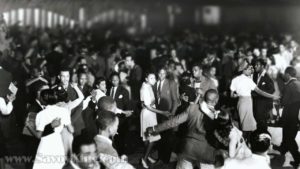Ping ponging with IFAST (Part 2): Thoughts on mentoring: Belief
 Teaching swing dancing as a skill is a great analogy of mentoring where failure equals loss.
Teaching swing dancing as a skill is a great analogy of mentoring where failure equals loss.
The art of social partner dancing is already rare. People do not want to feel like they look stupid. If you make them feel, regardless of how they actually look, like they look stupid, they will not come back. If you make them feel like something is overly complicated, they will not come back. Building a swing dance scene is a little bit like being a door-to-door salesperson; you have one opportunity to make your mark, or lose your audience forever.
On the other hand, people come to learn how to dance usually because they’ve seen other people dance. So they have an idea of what they want to look like. If you can’t deliver pretty fast on _that_, you’ll also lose them.
So, we have a learner who doesn’t know very much, but has an idea of what they want. Sounds familiar, doesn’t it?
When I used to teach swing dancing, my teaching partner, Sheila, and I would spend hours on curriculum development and lesson planning. What skills did dancers need to learn a flashy move; and could that be enough of a motivator to learn more vanilla basic concepts? How could we keep people coming back for more? We spent a lot of time thinking not only about skill progression, but also keeping things lighthearted (at first). For the most part, I think we did quite well. A lot of the students we taught back then are still active social dancers, and scene builders themselves.
When I moved back to Toronto after residency, however, I spent some time with my good friend Mandi Gould at her studio, Bees Knees Dance. Mandi and I have great discussions on our ideas of teaching. Her enrolment structure was quite different than ours though. While at the University swing club, we had the luxury of having 8-12 week courses, Bees Knees catered to a different non-school crowd, where committing to something for 2-3 months is actually a barrier. Bees Knees courses were 4 weeks long. Now _that’s_ a retention challenge, which Mandi met with enormous success. Her secret? Get them dancing right away; teach the steps later.
Traditional partner dancing programs do it the other way: Focus on steps and footwork first; then teach how to put them into a dance shape. It’s how I was taught. It was probably more along the lines of how Sheila and I taught. But shorter courses means more opportunity for drop-outs. The story of how Mandi got to her approach is also a great one, but perhaps for another day.
The slogan at Bees Knees is, “Anyone CAN dance”. Now THERE’S a hefty promise, eh? But the underlying message in this slogan is, “We believe that YOU CAN dance, even if you currently don’t think you can.”
So how does this come together in a post about mentoring?
In Part I, I talked about creating trust between a mentor and learner. We don’t push beginner dancers to just go and try things. They are already insecure about their movements. They also have no framework to decide if something “looks good”. But most importantly, telling beginners to go out and just try things increases the likelihood that they’ll try something and hate it, which reinforces the idea that they can’t dance. When we teach people to dance, we teach them the ways we know will make them look good; and this trust snowballs on itself, so that when we teach something REALLY cool, but awkward looking, like…peckin’, they’ll own it. It is also why we don’t teach “the octopus”.
Once you have cultivated trust, you can really start to push their boundaries; and this is where “Anyone CAN dance” comes in. Most people coming to their first lesson in swing dancing do not think they can dance. Most have never danced anything more than a step-tap-step-tap—if that. Mentoring a new dancer not only means teaching them the steps that will progress them to be a competent, good-looking dancer, but it means believing they are going to become a competent, good-looking dancer and allowing that belief to come through in your teaching. Eventually, their belief supplants your belief in them. They start to seek out the challenging stuff on their own. And then that’s when you see a passion (like, a fly-to-Sweden-and-live-in-a-dorm-of-bunkbeds-to-dance-14-hours-a-day-for-a-month kind of passion) bloom.
So I think the challenge in mentoring is identifying that progression of skill/understanding that is just beyond the learner’s reach that you know they can master, but are hesitant to do so. It’s not enough to just engage in a pure transfer of knowledge, or rely on the learner to maximize their experience. The role of mentor belief, I think, is the necessary training wheel that allows learners to eventually believe in themselves whether it’s as dancers, or professionals that ultimately propels them to the goal state of, “I don’t know everything, but I do know some things well.”
What opportunity have you given to your learner to show your belief in them?